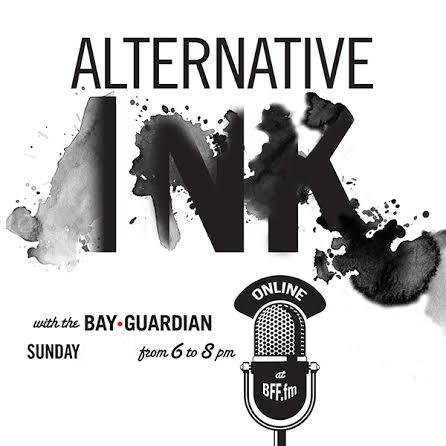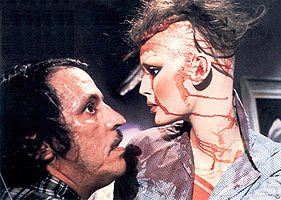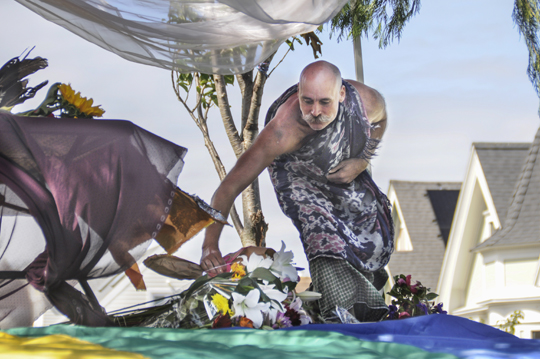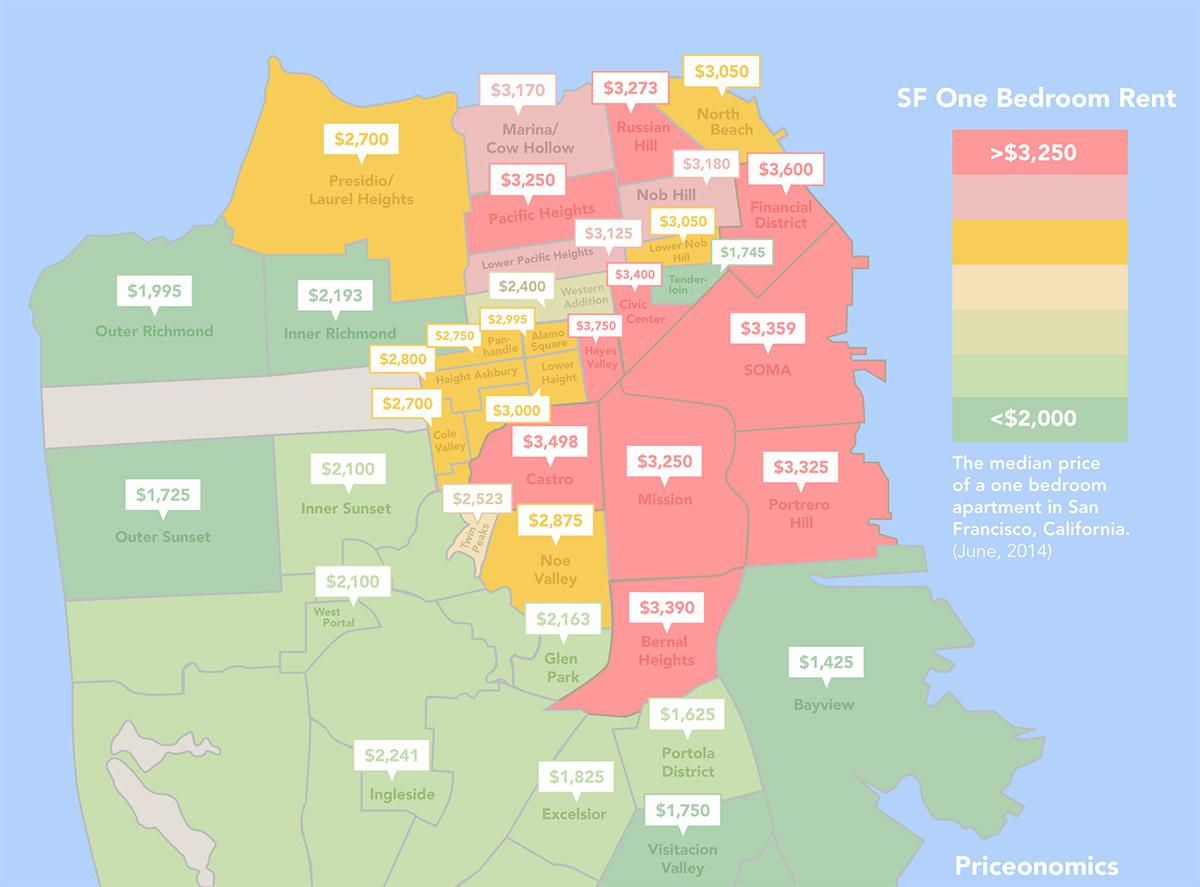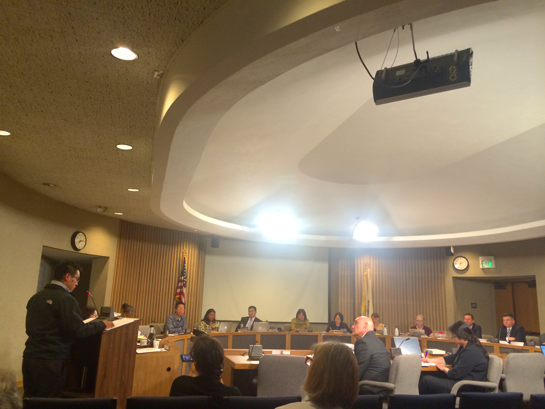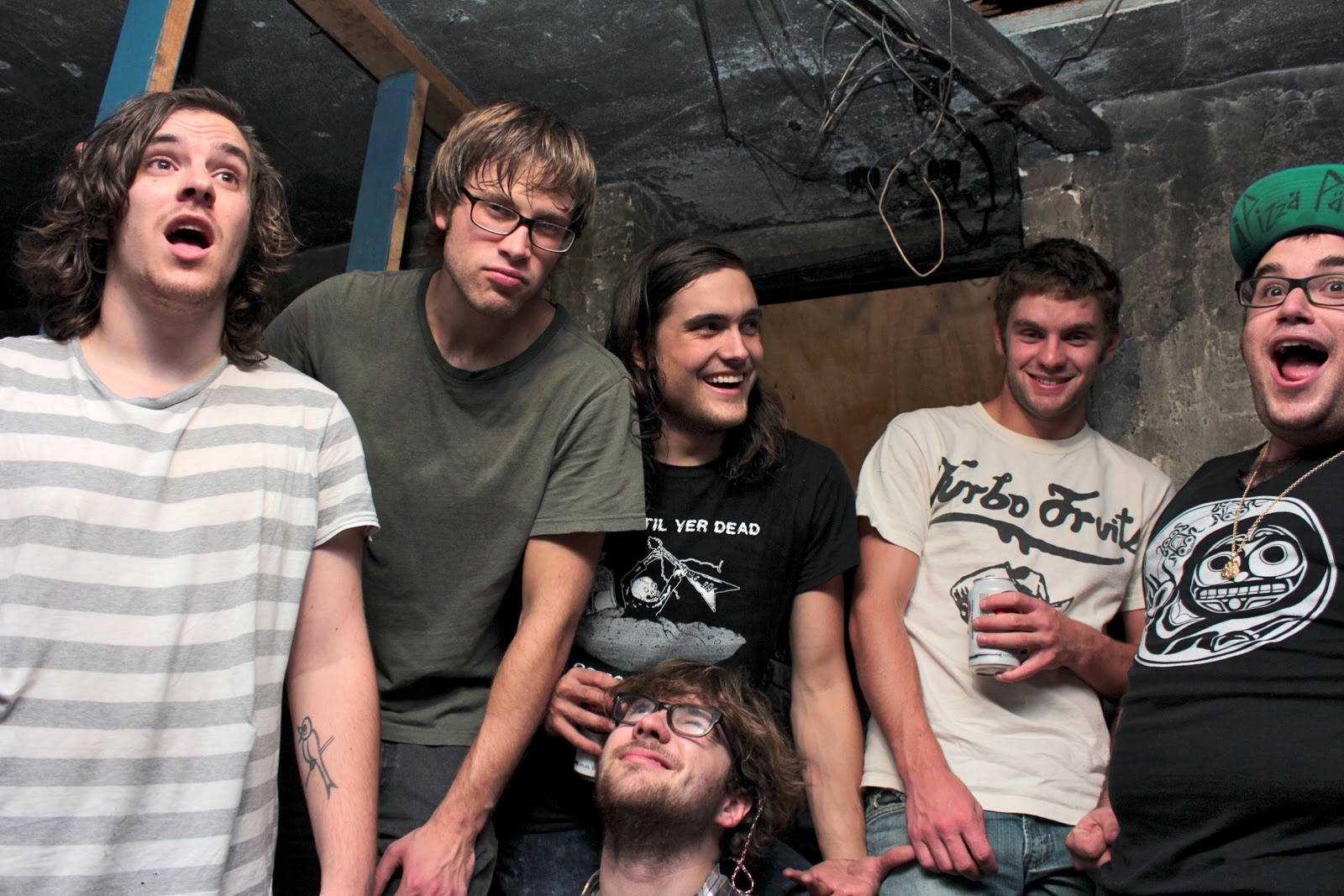Were you there? Were you among the approximately 200,000 human bodies smashed together for warmth at Golden Gate Park this past weekend, because you somehow couldn’t stand the idea of wearing anything but your midriff-baring tube top with your whimsical animal hat and/or flower crown?
Whether you’re recuperating today from 72 hours of partying at Outside Lands or patting yourself on the back from steering clear of the whole thing — here’s our critic’s take on the weekend’s best five sets…and the rest. Check this week’s paper (on stands Wednesday) for more live shots.
5. Mikal Cronin

Local boy Mikal Cronin. Photo by Brittany Powell.
If 28-year-old Mikal Cronin had signed a recording contract three decades ago, his breakthrough LP, MCII, just might have coexisted peacefully with Kiss’ Alive in “Freaks & Geeks”-y record crates across America. Arguably the greatest contributor to California’s recent wave of late-’70s power-pop revivalism, Cronin assuredly challenges 2014’s largely tongue-in-cheek fascination with the “me decade,” recalling arena bombast and dank basement charm with great conviction. Lead guitarist Chad Ubovich’s high-flying, joyously unironic guitar theatrics sealed the deal at the Panhandle stage on Friday afternoon, as Cronin and his three-piece backing band delivered the festival’s most wholesome slice of straightforward rock.
4. Jonathan Wilson
Saddled with the unenviable noon opening slot at the Sutro stage on Sunday, LA’s Jonathan Wilson treated a criminally small audience to another set of California rock revivalism with great strength of purpose. Evoking something in between late-’60s acid idealism and early-’70s comedown disillusionment, Wilson and his four-piece backing ensemble delivered a quietly confident, elegantly restrained set of swirly, jam-based rock headiness, devoid of the excessive noodling and uptight baroqueness that plagues so much of the competition. It takes serious talent to make such complex musical interplay sound so natural and relaxed. My favorite new discovery of 2014’s Outside Lands.
3. Haim

Two of three sisters Haim. Photo by Matthew Reamer.
If there’s one complaint to level at Haim’s live show, it’s that the Phoenix-y Botox-pop production of last year’s Days Are Gone is so immaculate and superhuman that replicating those songs onstage, in their recorded form, is damn near impossible. However, the sisterly trio has come a long way after a year of touring, and as Saturday’s main stage appearance triumphantly showed, Este, Danielle, and Alana Haim’s live approach is closer than ever to reproducing these Fleetwood Mac-indebted pop gems with the glossy sheen intact. From “The Wire,” to “If I Could Change Your Mind,” to ” My Song 5,” Haim delivered an hour-long hit parade, and a masterclass in guitar rock via R&B viscosity. Bonus points to Este’s rabble-rousing stage banter and uninhibited rubber-face while plucking the strings, and the generous thump supplied by Alana’s freestanding bass drum.
2. Jagwar Ma
Given the sheer amount of music-circa-2014 that exists in the gaps between genres, and electric/acoustic/electronic approaches, one might expect a zeitgeist-y festival like Outside Lands to reflect this sense of fusion onstage. For the most part, though, we were given the same old binary of traditionally outfitted rock bands on one hand, and laptop-driven hip-hop and electronica on the other. Australia’s Jagwar Ma, however, bucked that trend by supplying the biggest patch of middle-ground at the entire festival. Indebted to the Ecstacy-addled dance-rock hybridization of Primal Scream, Happy Mondays, and other mainstays of the UK’s Madchester scene, the three-piece’s Saturday afternoon set at the Twin Peaks stage perfectly combined guitars, synths, and other gadgets to reflect the sugary hookiness of ’60s psychedelia and the four-on-the-floor thump of acid house, without the slightest hint of awkwardness or contrivance. Performing sequencer-based music onstage, that’s also tactile and involving, is arguably the great challenge of modern live music, and Jagwar Ma effortlessly rose to the occasion.
1. Kanye West

Kanye, who wouldn’t let photographers shoot from anywhere but the sound booth, and who performed as a silhouette for a good chunk of the set, because he is Kanye. Photo by Matthew Reamer.
Whether you think of him as a mad-truth-speaking shepherd of pop culture, a vapid, window-dressing egomaniac, a bizarro performance artist, or a world-class troll, no one in the Grammy/VMA tier of the music world thrives on the ambiguity of their persona like Kanye West. In a landscape of major-label artists with carefully maintained PR images, delivering live shows akin to a federally regulated product, there’s a sense of uncertainty and precariousness about a Kanye performance that makes every moment captivating. Whether he was instructing the audience to “make circles!” and mosh during one of three playthroughs of “Blood on the Leaves,” freestyle-autotuning for 10 minutes over a bare piano track with video of a waterfall in the background, slipping his Robocop helmet/mirrorball mask on and off, or stopping midway through “Clique” for an impromptu rant aimed at the media that scrutinizes his every move, one couldn’t shake the palpable feeling that this train just might derail at any moment. Both tightly curated, and seemingly hanging by a thread, Friday night’s headlining set was bewildering and exhilarating in equal measure. In other words: pure, unfiltered Kanye.
“This ain’t no radio shit. This ain’t no shit made to please motherfuckers. This ain’t no concierge, maitre d’ music and shit trying to sound smooth as possible,” West declared during one of numerous manifesto-ish rants between songs, presumably referring to the lean, grating electro-thrash of last year’s hugely divisive Yeezus. That record made its mark with renditions of “Black Skinhead,” “New Slaves,” and “Bound 2,” and largely defined the show’s aesthetic, to the chagrin of many a festival-bro pining for “that 2007 shit” circa Graduation. Crowd-pleasers like “Good Life,” “Jesus Walks,” and “Diamonds From Sierra Leone” acted as a welcome counterweight to Yeezus’ radical aggression while putting that album’s adventurousness in perspective. As suggested by the solid, monumental blocks of color on the projection screens, Kanye’s presence was commanding and singular when the fragility of his ego didn’t get the best of him.
Explaining the reasoning behind his continued use of autotune, Kanye declared, “Same thing as Andy Warhol said: it’s easier.” Much like Warhol, or punk rock, the cultural import of Kanye’s current output lies more in the values and attitudes it represents, and the debate it generates, than its actual content. His set certainly wasn’t the festival’s most competent, nor its strongest on purely musical terms. But as pure spectacle, and as a launching pad for contemplation and discussion about the value of “art” and where it’s going, Kanye’s set reigned supreme. “It’s Yeezy season,” whether you like it or not.
*****
Honorable mentions

Flaming Lips. Photo by Brittany Powell.
Despite recent rumors of intra-member infighting, and allegations of Wayne Coyne being a racist asshole in the midst of a druggy midlife crisis, the Flaming Lips put on a stellar, perfectly charming show. Their signature, jerry-rigged stage theatrics were as gloriously gimmicky as ever, and their musicianship onstage has rarely been tighter. Their closing cover of “Lucy in the Sky With Diamonds” brought out SF’s fearlessly freaky vibes like nothing else at the festival.

Petty, bein’ Petty. Photo by Brittany Powell.
Tom Petty & the Heartbreakers delivered two hours of faithful takes on 40-ish years worth of rock anthems. So faithful, in fact, that the whole set seemed weirdly copied and pasted from an FM station at some dad’s backyard barbecue. A solid set, nothing more or less; lthough, the high standard set in years past by headliners like Paul McCartney and Stevie Wonder left a bit of star-power to be desired in the headlining slot.

Disclosure. Photo by Matthew Reamer.
Disclosure, the UK house revivalists whose hugely successful debut, Settle, can be heard over intercoms in Apple stores and Uniqlo franchises across America, drew an uncommonly huge crowd to the main stage for a Friday afternoon. Despite the undeniable quality of anthems like “When a Fire Starts to Burn” and “Help Me Lose My Mind,” the lack of live vocals and the inherent dullness of watching two dudes mess with laptops made for a slightly underwhelming set.

The Queen of Bounce herself, Big Freedia. Photo by Matthew Reamer.
Big Freedia lent her party-rap talents to the GastroMagic stage, while Brenda’s French Soul Food made beignets for a handful of hungry, twerking audience members. A low-key but surreal collaboration that resembled a wacko “happening” more than a standard festival show, hinting at the new food-centric stage’s full potential.
Stray observations:
Described as a “gourmet” festival like no other, Outside Lands had some shockingly tasty food options to offer this year. Wise Sons’ Deli’s “Pastrami Cheese Fries” and Michelin-starred AQ’s “Highbrow Spaghetti Sloppy Joes” were prime examples of smartly, expertly crafted dishes that still felt unpretentious and festival-ready.
Beer, beer, and more beer! Given the Bay Area’s distinction as one of the world’s epicenters of quality and invention in craft beer, the polo field’s Beer Lands station rose to the occasion admirably. A good selection of highly drinkable, floral “session IPAs” (from Sierra Nevada, Firestone Walker, and Stone), robust porters and stouts (most notably High Water’s s’mores-flavored Campfire Stout), and even barrel-aged brews (Fort Point’s Westfalia, a complexly funky take on an amber ale) presented just a few of many options.

Outside Lands detritus, after the storm. Photo by Matthew Reamer.
Too bad Ireland’s CHVRCHES had to C@NC€L after getting stuck at customs in Vancouver. I was excited to see what all the fuss was about.
One of Kanye’s many rants touched on the poison of negative criticism, and the press’ fixation on identifying the flaws in well-intentioned art. Going into Outside Lands, I promised myself to focus on the positive, to give each and every band the benefit of the doubt. However, the Killers gave me no choice but to break that rule.
What is this, 2004? What business do the Killers (a band that’s spent over a decade coasting on the fumes of its debut LP) have headlining a festival that prides itself on the relevancy of its lineup? We don’t see the Pitchfork Festival giving its premier slot to the likes of Interpol anymore. Also, how has this band (surely Las Vegas’ least hedonistic export) earned headlining power with its brand of aggressively “inspirational” secular Christian rock with no undertow of mischief, adventure, or much of anything? They couldn’t even cover Creedence’s “Bad Moon Rising” without giving off a big whiff of American Idol sterility. Sure, the synthesizers in the background make for some nicely textured rock music, but U2, even Coldplay, deliver the same goods far more substantially.
If the Killers were the “best choice” for Sunday night’s headliner, either 100 more worthy bands were busy, or the Outside Lands booking department could use some fresh blood. It’s 2014. There are bigger, fresher fish to fry.

Photo by Matthew Reamer.
Disagree? Have at us in the comments. We didn’t mean to insult your whimsical animal hat.

